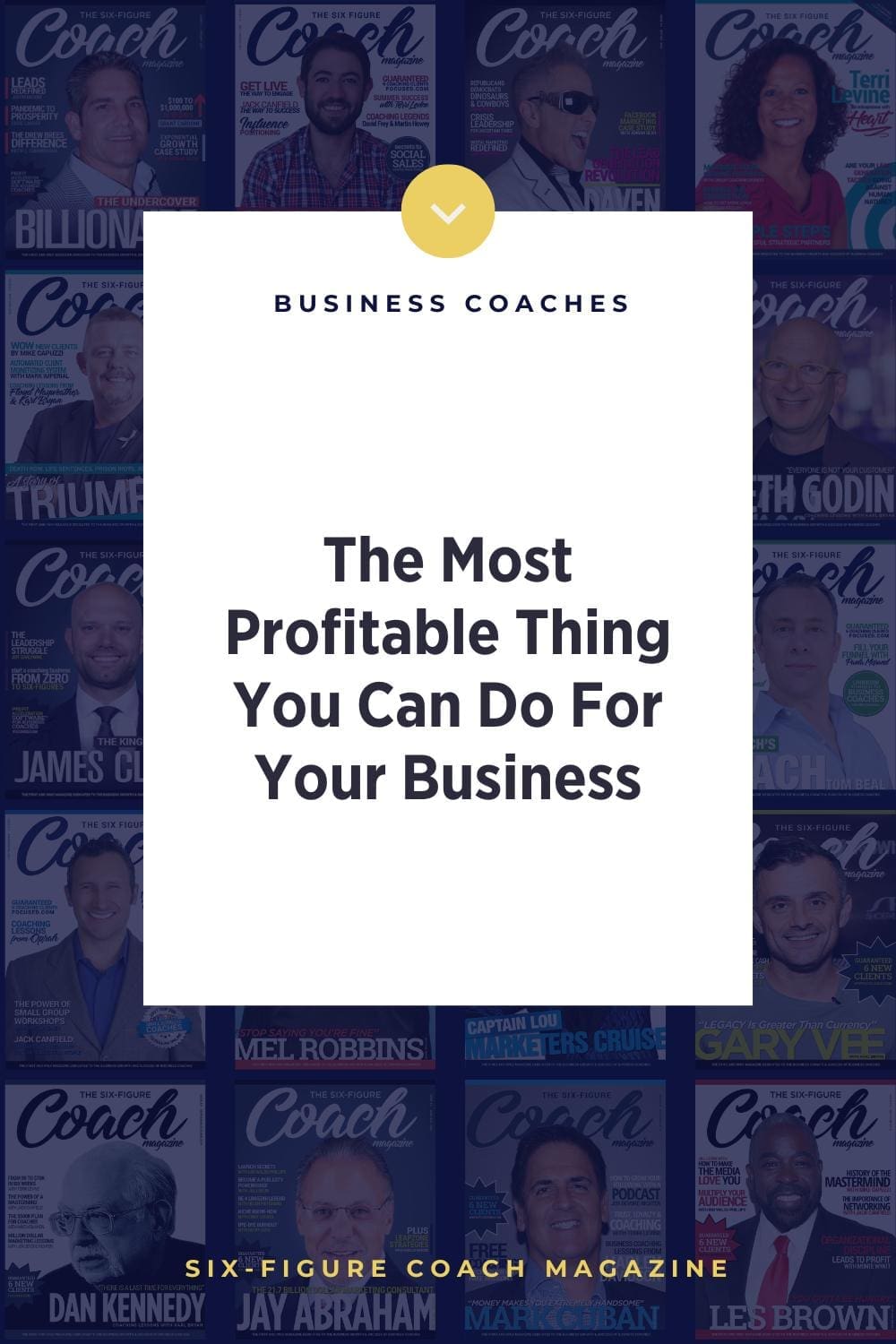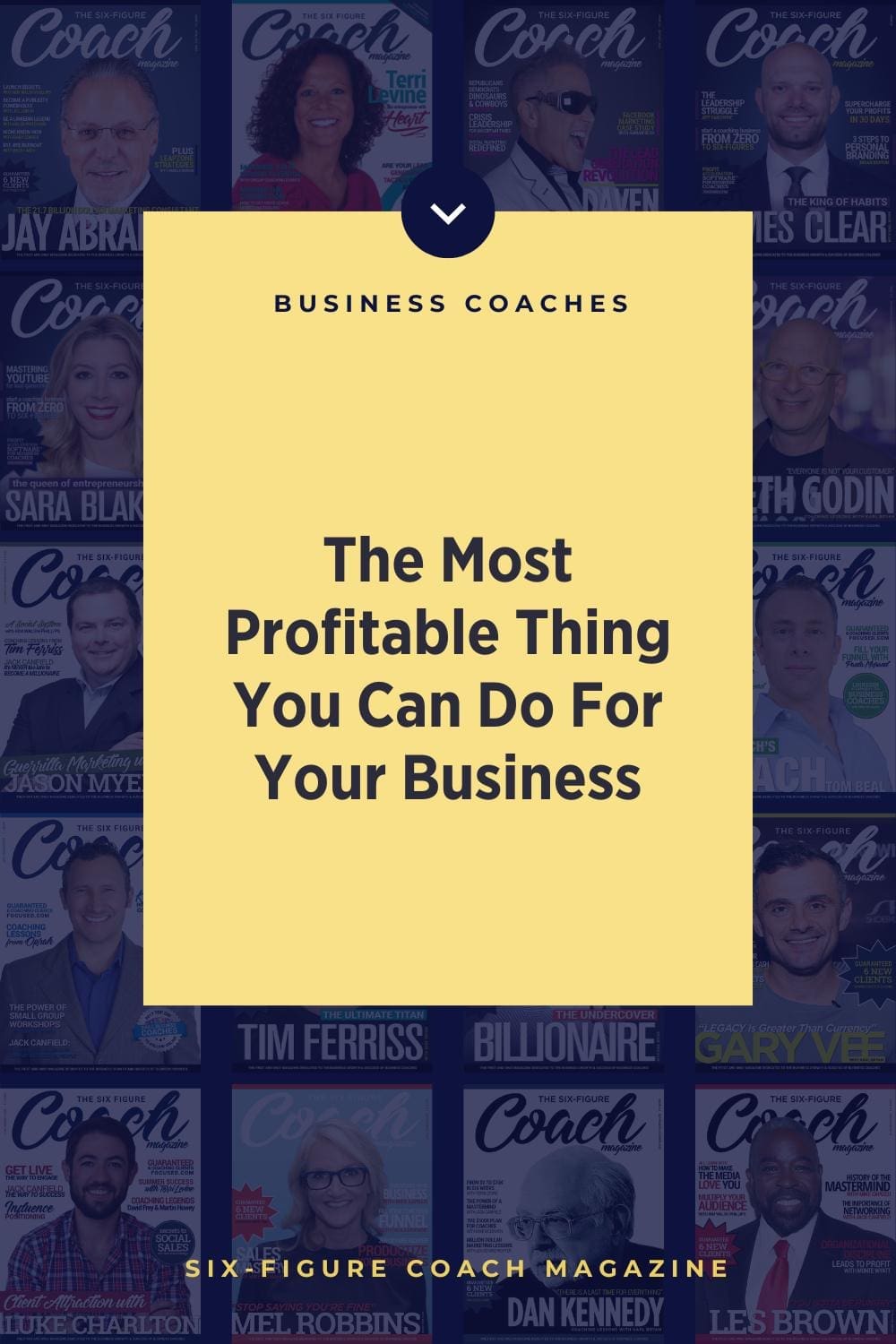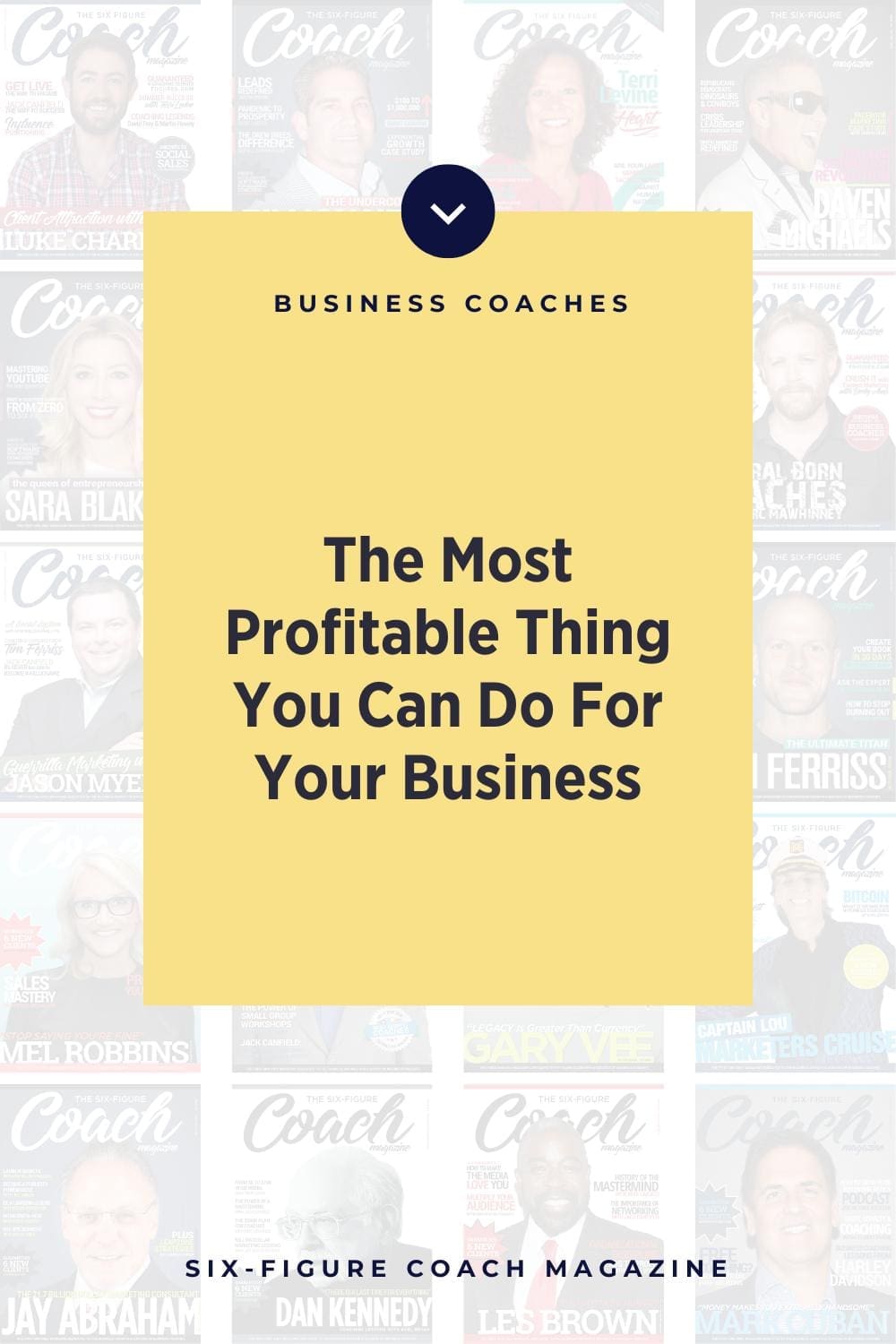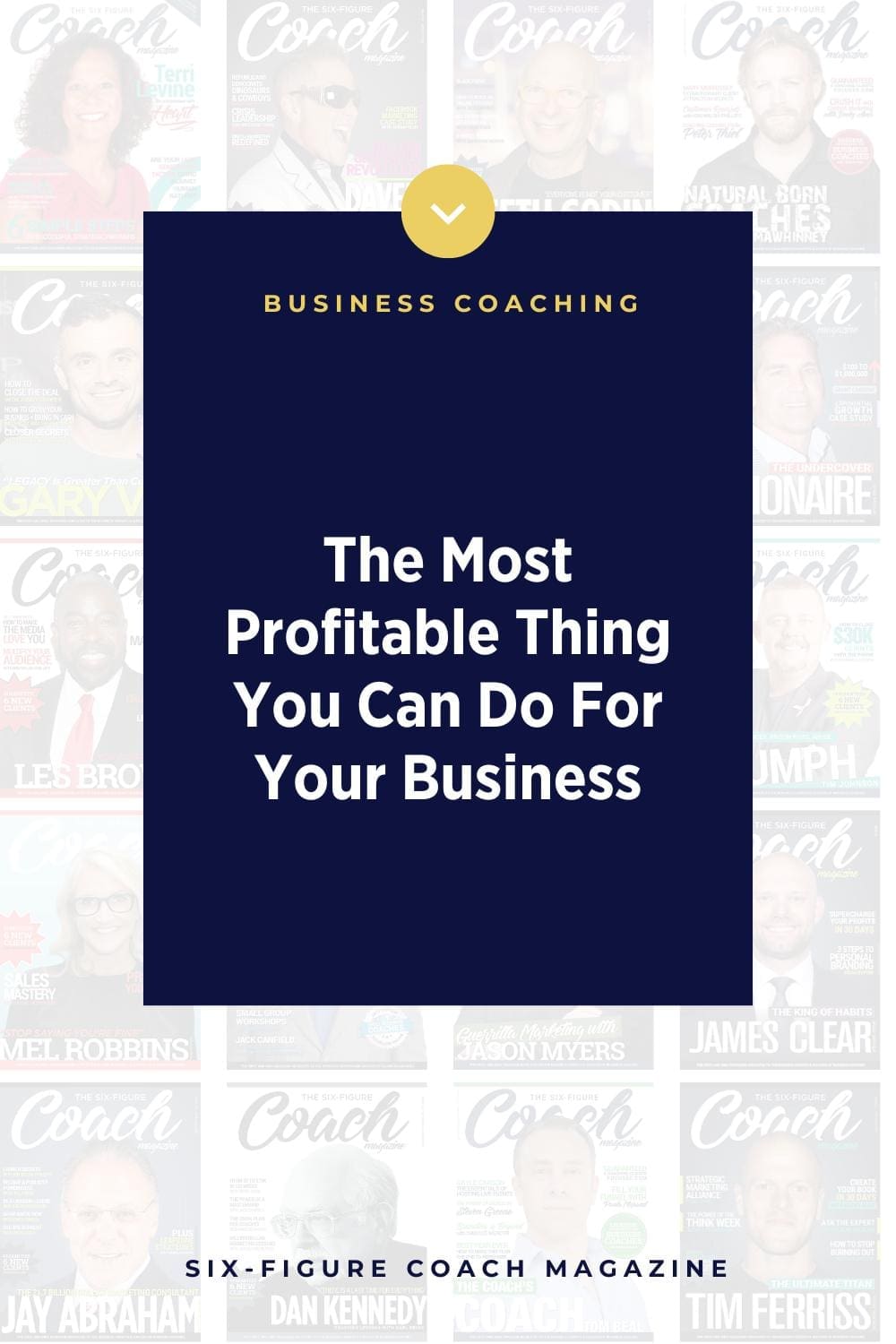The Most Profitable Thing You Can Do For Your Business with Becky Auer

There’s no question about it. Your existing customers are your most valuable assets. Since they’ve already purchased from you previously, and have experienced the benefits of your products and/or services (and presumably are pleased with you and those experiences), they are likely to stay a client and are likely to refer you to others who may have a need for your coaching and consulting.
Yet, nearly every business owner allots more money, time and effort to the acquisition of new customers than they do to keep their existing customers.
Based on statistics, it costs more than five times as much to bring a new customer on board than it does to retain existing ones.
It’s crazy because most business owners can tell you almost to the penny what the value of their furniture, fixtures and equipment is, as well as how much money they have tied up in stock and inventory.
Yet, when it comes to the most valuable asset they have – their customers, they don’t have a clue as to what they’re worth.
Determining the Lifetime Profit Value of a customer is simple…
And it’s the most profitable thing you can do for your business and those you coach.
If you’ll take a few minutes to work through the numbers you’ll find yourself well ahead of your competitors. And if you help your clients to do this, you’ll be a HERO forever in their eyes.
This one simple exercise can immediately place you ahead of 95 percent of other business coaches who compete against you.
The Lifetime Profit Value of a customer is simply the total profit produced by an average customer over his or her lifetime of doing business with you.
For the sake of example, we’ll use a restaurant. Let’s suppose that the first time someone goes there for dinner with two friends, the restaurant owner realizes a profit of $100 on that sale. And let’s say they come in again three more times during the course of the year, and each time they come in, the restaurant realizes another $100 profit. That’s $400 in total profits over the first year.
Now let’s say their average customer continues to eat with them for 5 years before they move, they die (not to be morbid) or they switch to another up and coming restaurant.
If they continue to go in at the same frequency and profit level for those next 4 years, that business will have realized $2,000 in profits from them during their “lifetime” of visits.
Of course these numbers are for illustration purposes only. You’ll have to use your own numbers to come up with a meaningful figure for the lifetime value of your own clients, and for those you coach or consult.
So what does all this mean? Well, if you know how much your average client is worth to you over the course of their lifetime, you gain several advantages over your competition.
For instance, if you know your average customer is worth $2,000 over the course of their association with you, you know how much you can afford to spend to keep that customer happy and coming back for more, and you’ll also know how much you can afford to spend to acquire a new customer.
Let’s say other business coaches are using a direct mail approach to contact their prospects. And if they’re like most people who use direct mail, they only send one introductory letter with one or two follow-up letters.
If they don’t get a response, they stop contacting that prospect and move on to another. But now you, knowing that the Lifetime Profit Value of your average customer is $2,000 (in our previous example), know that you can spend up to $2,000 to acquire that client and still break even.
Of course you don’t have to spend that much, but look at the leverage and advantage you have over your competitors just knowing what your numbers are.
And that’s not all. Let’s suppose that you give really great service (you do, don’t you?), and that your clients are thrilled enough with it to tell their other business associates about you.
What is the cost to you to acquire those folks as clients? They come on board as pure profit to you… no marketing costs whatsoever.
So, what should your marketing budget be?
Some coaches and businesses use a percentage of sales. Others use a fixed dollar figure. But think about it another way.
As long as you’re making a profit, why set a limit on your marketing budget?
Instead…
Spend whatever you can afford so long as the acquisition costs are less than the profits you make on your average client.
The only limiting factor should be your cash flow. And as you increase your number of clients and your profits, increase your marketing budget as well. Figuring out exactly what your average client is worth to you (their sales plus the profits on any referrals they send you), can be one of the most important things you can do as a business coach – and as someone who teaches and provides guidance to business owners.
Take a minute and check out the tables below. You’ll see just how valuable each of your clients are.
Below is a table titled, “Restaurant Example.” This is what I used at my restaurant when I was explaining to my employees how the Lifetime Profit Value of a Customer was determined. Feel free to use this for yourself and/or your business owners.
Restaurant Example
A. Amount of average sale
$ 50
B. No. of sales/year/customer (2 visits per month)
24
C. No. of years customer patronizes restaurant
10
D. No. of referrals from customer
10
E. % of referrals who become a customer
50 %
F. Gross income per year per customer (A x B)
$ 1,200
G. Gross income over buying lifetime (F x C)
$ 12,000
H. Referrals who become customers (D x E)
5
I. Gross income from referrals (G x H)
$ 60,000
J. Total value of a loyal customer (G + I)
$ 72,000
|
Restaurant Example |
|
|
A. Amount of average sale |
$ 50 |
|
B. No. of sales/year/customer (2 visits per month) |
24 |
|
C. No. of years customer patronizes restaurant |
10 |
|
D. No. of referrals from customer |
10 |
|
E. % of referrals who become a customer |
50 % |
|
F. Gross income per year per customer (A x B) |
$ 1,200 |
|
G. Gross income over buying lifetime (F x C) |
$ 12,000 |
|
H. Referrals who become customers (D x E) |
5 |
|
I. Gross income from referrals (G x H) |
$ 60,000 |
|
J. Total value of a loyal customer (G + I) |
$ 72,000 |
Following the Restaurant Example are two additional tables that you can use to determine the LPV of your own customers or clients. Don’t pass these tables up. Make sure you take the time to complete them.
In the first table, “The LPV Of Your Customers (Actual)”, put in the figures as they relate to your current business. This will tell you what the actual value of your customers or clients is to you. In the next table, “Optimizing The LPV Of Your Customers”, you can see what will happen to the value if you affect an increase in any of the areas.
The LPV Of Your Customers (Actual)
A. Amount of profits from average sale
$
B. No. of sales/year/customer
C. No. of years customer buys from you
D. No. of referrals from customer
E. % of referrals who become a customer
%
F. Amount of profits per year per customer (A x B)
$
G. Profit value over buying lifetime (F x C)
$
H. Referrals who become customers (D x E)
I. Amount of profits from referrals (G x H)
$
J. Total value of a loyal customer (G + I)
$
|
The LPV Of Your Customers (Actual) |
|
|
A. Amount of profits from average sale |
$ |
|
B. No. of sales/year/customer |
|
|
C. No. of years customer buys from you |
|
|
D. No. of referrals from customer |
|
|
E. % of referrals who become a customer |
% |
|
F. Amount of profits per year per customer (A x B) |
$ |
|
G. Profit value over buying lifetime (F x C) |
$ |
|
H. Referrals who become customers (D x E) |
|
|
I. Amount of profits from referrals (G x H) |
$ |
|
J. Total value of a loyal customer (G + I) |
$ |
Optimizing The LPV Of Your Customers (+10%)
A. Amount of profits from average sale
$
B. No. of sales/year/customer
C. No. of years customer buys from you
D. No. of referrals from customer
E. % of referrals who become a customer
%
F. Amount of profits per year per customer (A x B)
$
G. Profit value over buying lifetime (F x C)
$
H. Referrals who become customers (D x E)
I. Amount of profits from referrals (G x H)
$
J. Total value of a loyal customer (G + I)
$
|
Optimizing The LPV Of Your Customers (+10%) |
|
|
A. Amount of profits from average sale |
$ |
|
B. No. of sales/year/customer |
|
|
C. No. of years customer buys from you |
|
|
D. No. of referrals from customer |
|
|
E. % of referrals who become a customer |
% |
|
F. Amount of profits per year per customer (A x B) |
$ |
|
G. Profit value over buying lifetime (F x C) |
$ |
|
H. Referrals who become customers (D x E) |
|
|
I. Amount of profits from referrals (G x H) |
$ |
|
J. Total value of a loyal customer (G + I) |
$ |
To calculate % increase: (Subtract Original “J” from Increased “J” and divide the answer by Original “J”)
To calculate % increase: (Subtract Original “J” from Increased “J” and divide the answer by Original “J”)
You should also Calculate The Cost Of Losing A Client (or Customer)
The “ripple effect” is one of the most powerful forces in business, and it can affect you both in a positive manner as well as negatively.
Above I discussed how valuable each of your clients can be to you over time.
It’s called the Lifetime Profit Value of your clients. Now, let’s take a look at what the cost could be to you if you lost a client instead of gaining one.
To make it easy, let’s use our same restaurant as an example. Suppose for a minute that you or one of your restaurant employees got upset with a customer and the customer stopped going there.
No big deal, right? I mean, it was just one customer. And it’s not too difficult to get another one to replace them. How much would that restaurant lose if they never returned?
In our previous example – $2,000.
But let’s take a closer look at how the ripple effect could impact that one bad experience between the restaurant and the customer.
If that unhappy customer were to tell 12 other people about their bad experience (or not refer those 12 people to the restaurant), and each of those 12 were to tell six others, the total number of people affected by that one bad experience would total 85. (6 x 12 = 72 + 12 = 84 + the original unhappy customer = 85). And in the world of the internet, that can happen within minutes of an unhappy customer leaving.
Now, if only 25 percent of those people chose not to even try that restaurant; that comes to 21 people.
If each of those 21 had similar habits as the original customer, the total lost revenues would be $42,000! (That’s $2,000 x 21 people.)
$42,000… all from one bad experience!
But what if those figures are way off, and it’s only 10 percent of that amount? That still totals $4,200.
That’s a lot of money for letting one person leave the restaurant dissatisfied. And here’s an unfortunate situation to consider: often people are unhappy and leave, and you don’t know it.
They may get their feelings hurt, feel slighted or have something completely unexplained happen and take their business somewhere else. And you never knew anything about it.
Here’s a quick calculator that makes it easy to determine just how much you lose when a customer has a bad experience in any business. The figures are based on what we’ve just discussed:
The Cost of Losing a Customer
1. The Dissatisfied Customer
1
2. Tells (12) others
12
3. They each tell (6) other people
72
4. Total bad experiences shared with others
85
5. About (at least) 25% do not go back to that business because of this bad word of mouth
21
6. Average Lifetime Profit Value of Customer
$2,000
7. Lost income over 10 years from one bad experience
$42,000
|
The Cost of Losing a Customer |
|
|
1. The Dissatisfied Customer |
1 |
|
2. Tells (12) others |
12 |
|
3. They each tell (6) other people |
72 |
|
4. Total bad experiences shared with others |
85 |
|
5. About (at least) 25% do not go back to that business because of this bad word of mouth |
21 |
|
6. Average Lifetime Profit Value of Customer |
$2,000 |
|
7. Lost income over 10 years from one bad experience |
$42,000 |
The Cost of Losing a Customer
1. The Dissatisfied Customer
2. Tells ______ others
3. They each tell ______ other people
4. Total bad experiences shared with others
5. About (at least) ______% do not shop with you because of this bad word of mouth
6. Average Lifetime Profit Value of Customer
$
7. Lost income over 10 years from one bad experience
$
|
The Cost of Losing a Customer |
|
|
1. The Dissatisfied Customer |
|
|
2. Tells ______ others |
|
|
3. They each tell ______ other people |
|
|
4. Total bad experiences shared with others |
|
|
5. About (at least) ______% do not shop with you because of this bad word of mouth |
|
|
6. Average Lifetime Profit Value of Customer |
$ |
|
7. Lost income over 10 years from one bad experience |
$ |
So what do you do about it?
You MUST treat each of your clients and customers the very best way possible. Give them all the love, care, attention and service you can. Kill them with service. Go overboard. Under-promise and over-deliver – EVERY TIME! Make it nearly impossible for them to even consider doing business with anyone else but you, regardless of price, location, convenience or any other reason. Become not only the preferred person (or place) to do business with, but the ONLY consideration your customers, clients and prospects have.

About Becky Auer
Becky Auer has started 3 multi-million dollar businesses. The last was a Japanese Steakhouse and Sushi Bar that she took from $0 to $6.5M in just over a year and kept it there until she sold it. Becky runs group coaching and mastermind groups as well as coaching private clients. For Free Resources, go to www.BeckyAuer.com.






